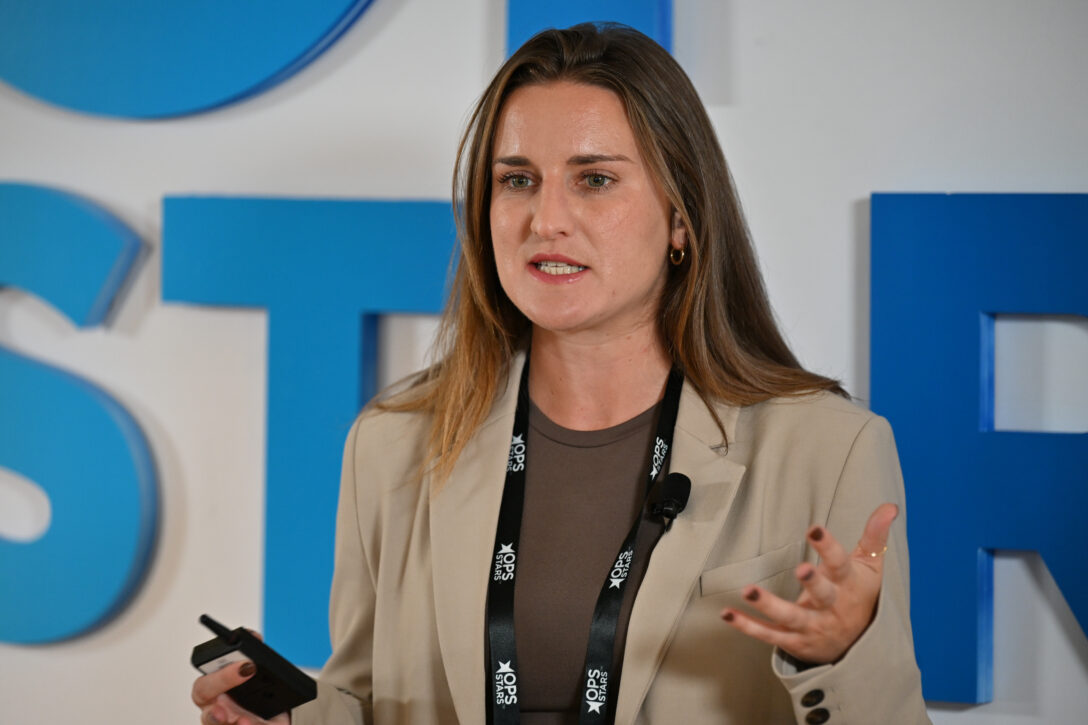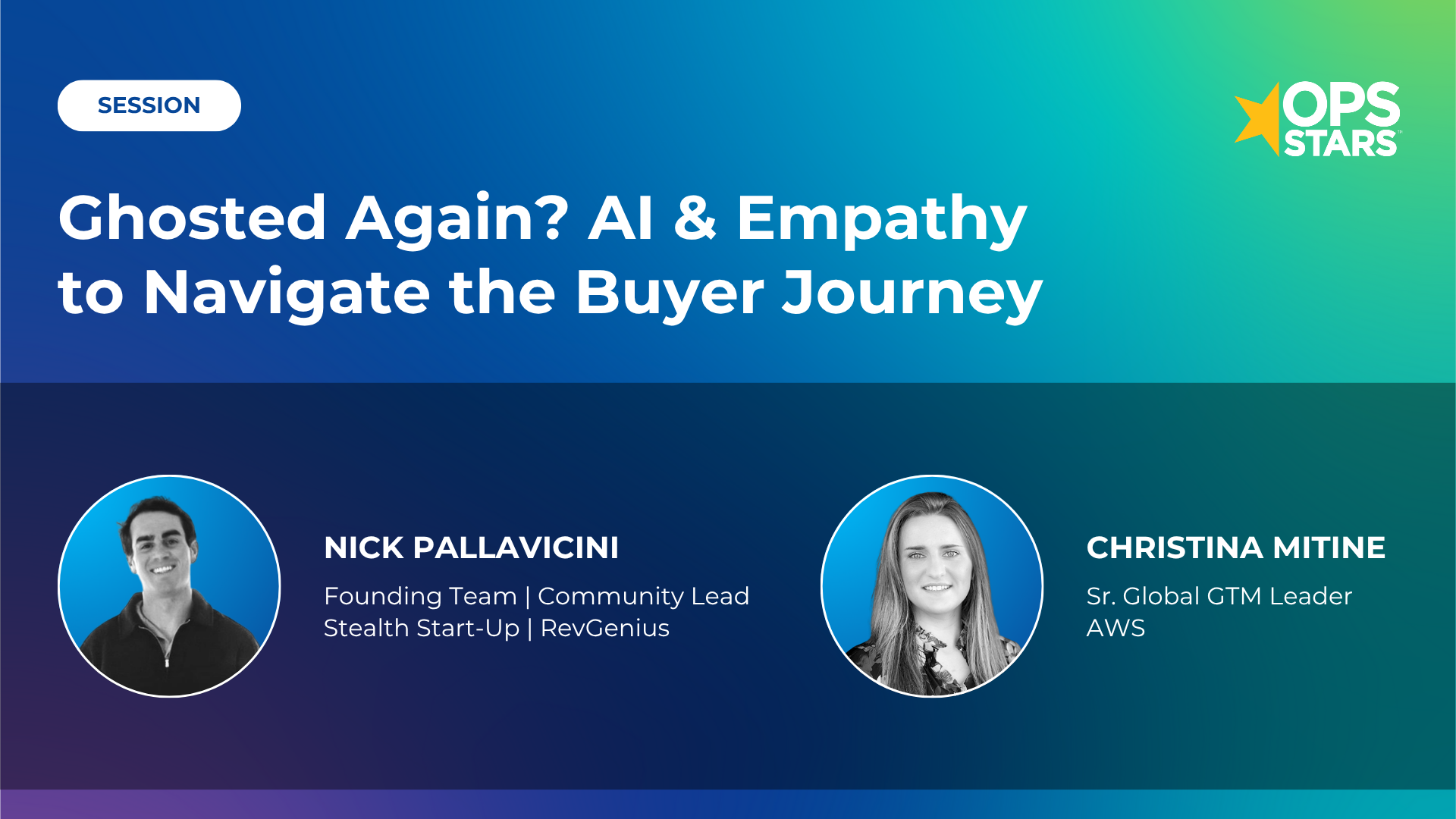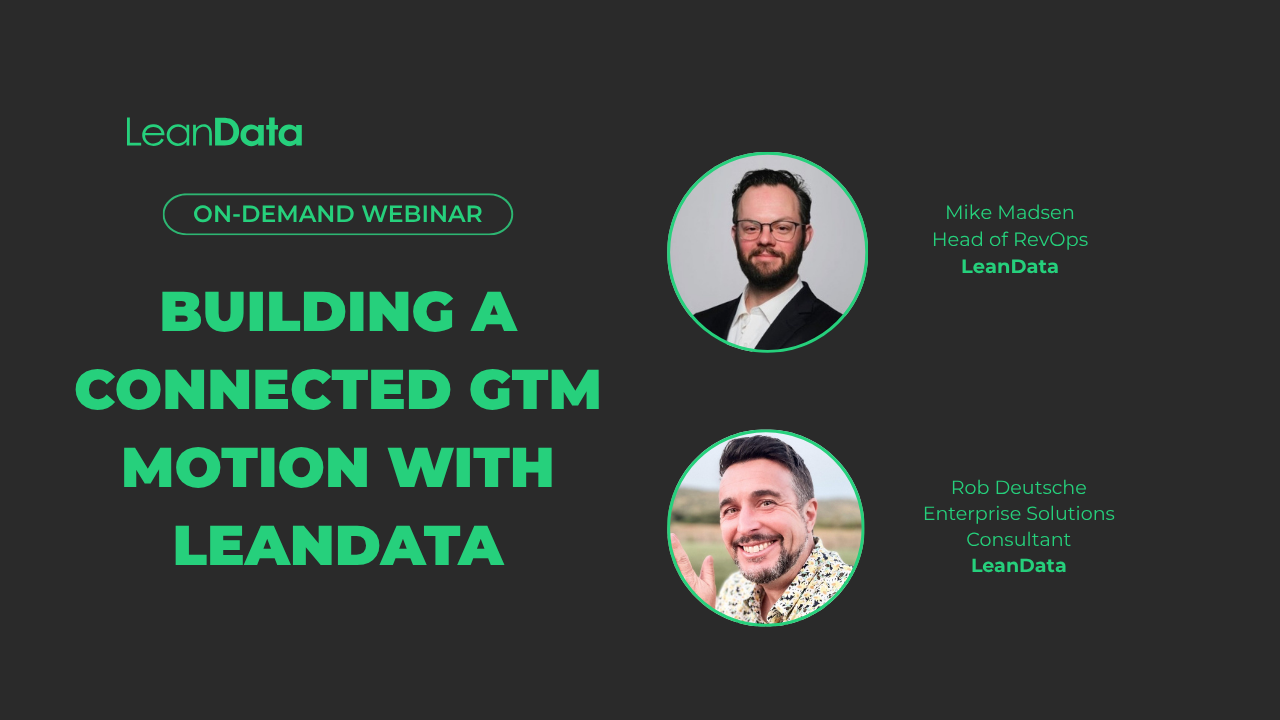Summary
Ghosting is rarely a hard “no.” It is usually a signal that the buyer journey broke somewhere between intent, routing, and follow-up. In this OpsStars session, AWS’s Christina Mitine and operator–founder Nick Pallavicini share a practical, four-step playbook to detect buyer silence, diagnose why it happened, design value that unblocks the deal, and deliver it with empathy in the channel your buyer actually uses. Perfect for RevOps, Sales Ops, and Marketing Ops leaders building signal-driven, human-first motions.
Key Takeaways
- Silence is diagnostic, not definitive. Treat “no reply” as a signal of misalignment, unclear value, or process friction, not disinterest.
- Pair AI with empathy. AI detects behavior shifts; a human in the loop rebuilds trust and context to move the deal forward.
- Build a simple buyer radar. Stream CRM events into an agentic layer that flags risk and nudges reps in Slack, email, or wherever they work.
- Run the “4D” framework on one stalled deal this week: Detect signals, Diagnose causes, Design the asset, Deliver with empathy.
- Measure confidence, not touches. The end goal is buyer confidence that leads to Closed Won, not more activity logs.

Speakers
Christina Mitine — Senior Go-to-Market Leader, AWS
Christina helps enterprises adopt AI and messaging solutions in the cloud. She champions a “human-in-the-loop” approach where empathy guides how teams respond to buying signals.
Nick Pallavicini — Operator and Founder
Nick has scaled a fractional RevOps firm and now builds tools that help founders and exec teams create content. His work focuses on turning scattered engagement breadcrumbs into timely, trusted action for sellers.

What You’ll Learn
Q: Why do buyers “ghost” even after a good call?
A: Most ghosting stems from misalignment, unclear internal value props, or friction in your motion, not rejection. Treat silence as a diagnostic signal and locate the breakdown before you chase.
Q: Where should AI fit in my sales motion?
A: Use AI to watch for behavior changes (opens, visits, stakeholder updates) and surface patterns. Then let humans interpret the “why” and respond with empathy and relevance.
Q: What is the buyer radar and how do I start?
A: Pipe CRM and engagement signals into an event stream and lightweight agent that alerts reps in their flow of work (Slack, email, phone). Start with one fielded signal and one channel; expand from there.
Session Transcript
Christina Mitine
All right, quick show of hands. Who here has ever been ghosted professionally or personally? Don’t be shy, it’s okay. It’s pretty universal, right? It’s not just buyers, it’s recruiters, partners, and that prospect who promises to circle back and never does.
The silence feels personal, but it’s usually a systems problem. Many of us in ops experience this daily: data gaps, process drift, and missing context. In both dating and selling, people tend to disappear when communication breaks down, expectations misalign, or decisions get too complex.
You’ve all heard it before: your buyer says they’re looping in procurement, and then they fade away.
What’s changed today is that AI can reveal those trends, and when you combine AI with empathy, you can act on those signals with purpose. That’s what we’ll dive into today — how to decode silence and rebuild momentum with AI and empathy to navigate the buyer journey.
I’m Christina, a Senior Go-to-Market Leader at AWS. I help organizations adopt AI and messaging solutions in their cloud infrastructure, and I’m also a member of Women in Revenue.
Nick Pallavicini 04:07
I’m Nick Pallavicini. As Christina mentioned, I used to sell drywall before moving into RevOps. I created a company called RevPAL, which scaled to a million in ARR as a fractional RevOps company. I’m now building a stealth startup called Blazel, where we help founders and executive teams create content.
We’ve both seen that ghosting isn’t a people problem, it’s a revenue signal problem. The data is there — it just isn’t being routed or interpreted fast enough.
Our goal today is to show you how to read those signals differently so your teams can reconnect with the right buyer at the right time and in the right way — with empathy.
Here’s what the data shows: 86 percent of people between ages 18 and 42 have been ghosted in dating, and 62 percent of B2B buyers ghost sales reps. It’s not a coincidence. There’s a behavioral overlap.
In dating, someone reads your message, you see the dot-dot-dot, and no reply. In sales, a buyer opens your proposal — maybe the DocuSign — but never responds. Both situations reflect overload, not rejection.
Buyers leave digital breadcrumbs: website visits, LinkedIn engagement, content downloads. But little of that context ever reaches the rep. The challenge isn’t getting more data, it’s interpreting the right signals — from intent to routing to follow-up.
How many of you have had a deal go quiet in the last 30 days? I have two.
One example: two weeks ago, I had a deal with a company called Estuary.dev. The first two calls went great. I even got them into a Slack channel. As soon as I sent the proposal, they went cold.
So my team created an agent that scraped their recent LinkedIn posts and built what we called a “writing style guide.” We sent a message using that style, and two days later, the prospect replied, asked me to resend the deal, and signed it within 30 minutes.
Here’s our roadmap for today:
- The ghosting problem — why buyers disappear and why silence rarely means no.
- The new playbook — how to combine AI with empathy.
- The practical 4D framework — systems that work with sellers and meet them where they are.
- And finally, a closing challenge that you can try this week.
Ghosting is rarely about a lack of interest. Deals collapse under their own complexity. There are too many stakeholders, unclear ownership, shifting priorities, and teams forget the “why you, why now.”
I was once ghosted by the biggest deal of my career — Redfin. I was selling mobile app notifications. My champion went on parental leave, and the deal went quiet.
Instead of trying to sell, I reached out just to say congratulations. A few days later, she replied, asked how I was doing, and asked about the deal. I told her it went cold. She noticed the effort I’d put in and reintroduced me to a new champion. We rebuilt the relationship and closed the deal.
It all came from empathy — showing genuine care. Empathy goes a long way.
Reps experience silence behind the scenes all the time. Enterprise deals have so many stakeholders that it’s easy for communication to break down. Technology gives us clues: CRM updates, engagement data, intent tools, LinkedIn, and more. But those signals are scattered across systems like HubSpot and Salesforce, left untouched in custom fields or dashboards that nobody opens.
The key is creating a feedback loop between buyer behavior and seller awareness so silence becomes a signal to act on, not a reason to panic.
Christina Mitine 08:55
What we’re showing is that silence rarely means no — it’s diagnostic. It shows where the buyer journey broke down.
Misalignment: your buyer is overwhelmed by internal chaos or unclear value. They can’t make your business case to leadership.
Friction: when your sales and ops teams aren’t aligned, your process adds pressure instead of clarity.
A buyer ghosts you after a pricing call, not because they’re done, but because procurement or finance made a decision without telling them.
Your champion stops opening emails, not out of disinterest, but because they’re rewriting their internal business case. If you don’t have a feedback loop, you’ll never know.
When you tag these patterns incorrectly in your CRM — missed meetings, no contact, stalled opportunities — that’s where AI can help.
AI detects friction points, shows who’s opening what, and flags who’s gone quiet. It saves time and allows humans to layer on empathy to respond the right way.
Nick Pallavicini 10:18
AI gives us precision, but never permission. It can detect patterns and surface insights, but it can’t rebuild trust.
Teams often roll out personalization that’s really robotic. “Hi Nick, I saw you downloaded our white paper” — that’s not personal.
AI is only as good as its users. Without domain expertise, these tools won’t help. AI can’t re-engage stakeholders on its own, but it can surface the insights and triggers that let you do deeper research without spending hours hunting for intent data.
Christina Mitine 11:03
Empathy is the differentiator. It’s the multiplier. It’s a skill your competitors can’t easily replicate.
It’s not about being soft or nurturing. It’s about understanding context. Empathy means asking why your buyer went quiet instead of assuming disinterest.
I led a large-scale customer migration last year. One key stakeholder went quiet mid-project. Instead of pushing for an update, we researched and learned their company was reorganizing after layoffs.
So we pivoted our message to focus on stability — how our people could help. We got an immediate response.
When sellers pause to ask, “What could be happening internally for my buyer right now?” it changes the tone of every follow-up. It turns sequences into real conversations.
Nick Pallavicini 12:31
This is the new playbook. It creates a feedback loop between engagement data and your CRM to build trust.
AI detects who’s engaging and what’s changing, helping you strengthen your “why you, why now.”
Empathy interprets why the behavior matters and builds human connection. Together, they shift focus from chasing pipeline to building buyer confidence.
No more touches — more trust.
Christina Mitine 13:10
Many reps today are drowning in tabs — Salesforce, Slack, LinkedIn — and each tool tells part of the story but not the whole picture.
We’ve become detectives, piecing together clues from dozens of tools. On any given day, I have 40 tabs open.
One of my media and entertainment customers went silent after months of meetings. The account team tried everything: emails, texts, new stakeholders, procurement outreach — no traction.
Then I noticed one of the engineering leaders had posted on LinkedIn that he was coming to San Francisco for a competitor’s conference.
I asked the account team to reach out and mention the post. He agreed to meet for 12 minutes. I pitched one product feature — and that meeting earned us a seat with their executive team in New York. As of last week, we’re now in their RFP.
That’s the power of connecting signals. It’s not about more data or more systems. It’s about smarter visibility — using AI to detect signals and act before an opportunity is lost.
Nick Pallavicini 15:44
Here’s what it can look like technically — what we call the buyer radar.
Data flows from your CRM into an event stream through an AI or agent layer. It can notify reps in Slack, email, or wherever they work.
The magic isn’t the stack, it’s the sequence. You can build this in any cloud: AWS, GCP, or no-code tools.
Agentic AI acts as a co-pilot, watching for changes like activity drops or new stakeholders. It flags issues before humans can see them.
Imagine your CRM whispering, “Hey, your buyer who went cold two weeks ago just posted about a new product launch your solution supports.” That’s real-time intuition built into your workflow.
Christina Mitine 17:22
What we want to leave you with is a practical 4D framework — a bridge between insight and action.
Detect signals, diagnose causes, design the asset, and deliver with precision.
AI scans, humans connect. Together, they align insight, process, and follow-up.
Detection is pattern recognition. You see who’s opening decks, visiting your website, or engaging on social. AI agents watch for behavior changes and create a “ghosting snapshot” showing risk level and next steps.
Diagnosis turns observation into understanding. Ask why patterns changed. Did the budget freeze? Did someone leave?
AI can summarize notes, analyze CRM fields, and highlight risk factors. You add empathy to interpret what the data can’t show.
Nick Pallavicini 19:35
Once you understand the blocker, design assets that unblock the deal — an ROI calculator, a finance slide, or a 30-second video. Tools like Canva or ChatGPT make this fast.
It’s not automation replacing creativity; it’s amplifying it.
Delivery is timing and channel. If your buyer lives on Slack or LinkedIn, don’t rely on email.
Reach buyers where they are, and use AI to nudge you when signals spike.
Here’s your challenge: pick a stalled deal and apply the 4D framework. Ask, what signals am I missing? What value can I add? What’s the empathy move that could reopen the door?
Silence often hides opportunity. When you connect signals with storytelling, you improve win rates and create systems that drive empathy at scale.
Christina Mitine 20:57
Thank you all for joining us today. We’re happy to take questions, and you can find us on LinkedIn to stay connected.









